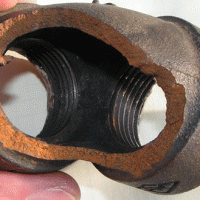The ongoing frigid temperatures serve as a reminder of the many investigations by Warren engineers involving fire sprinkler systems that have failed when some part of the system was exposed to the sub-freezing conditions. Interestingly, failures do not necessarily occur within the area of greatest freeze exposure, as the failure mechanism is the extreme pressure that results from the growth of an ice plug inside the exposed pipe in which the high pressure will rupture the weakest component which may even be located in a heated area of the sprinkler system.
The code governing the installation of fire sprinkler systems, NFPA 13, requires protection of the system against freezing. In residential and most commercial installations, this protection generally takes the form of routing the sprinkler piping within insulated areas, provided that the temperature within the insulated area can be reliably maintained above 40° F (4° C).
Freeze damage in this kind of application often occurs due to the failure to provide insulation protection for each and every section of piping. The use of foam sleeve insulation over piping in an unheated area is not adequate to provide the required protection from freezing, as the temperature of piping encased in the insulating sleeve will fall below freezing during periods of sustained low temperatures. The insulation installer must be diligent in assuring that even the remotest and most difficult to access components are protected. Damage can also occur when long-term power outage causes a building’s heat source to be non-operable.
When a sprinkler system is installed in unheated areas, the method of protection is usually by use of a dry system, wherein the system is charged with air rather than water, until a fire is detected. Dry systems must be routinely tested, at which time the system is filled with water. If the water in the system is not properly drained completely from the system following the test, the system is subjected to freeze damage when the temperature falls. Failure can occur if the piping system is not properly sloped toward the drain at the time of installation, or the slope is altered during building modification. Failure has also been seen due to the failure of the tester to open all drains within the system following the system test.
If we can help you in a case involving frozen piping, just let us know.
Founded in 1997, The Warren Group, forensic engineers and consultants provides technical investigations and analysis of personal injury and property claims as well as expert testimony for insurance adjusters and attorneys. Extremely well versed in the disciplines of mechanical, electrical, chemical, structural, accident reconstruction and fire and explosion investigation, our engineers and consultants are known for delivering the truth — origin, cause, responsibility and cost of an event or claim — with unmistakable clarity.






